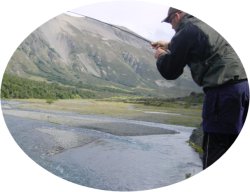 It was Jim Curry who said to me “You know Paul, when I see a fish I make a point of not looking at him”
It was Jim Curry who said to me “You know Paul, when I see a fish I make a point of not looking at him”
"That's funny Jim, because I do a similar thing except when I see a fish I pretend not to see him"
(pause)
"I think they know"
(pause)
"We must be projecting energy through our eyeballs, Jim"
"That'll be it"
The funny thing is I have always been like this. Maybe it's some primeval hunting instinct, some genetic hand-me-down; this knowledge that we mustn't look directly at out quarry, or at least not when we are thinking about hooking/catching/eating them. OK I'm in danger of going way off the scale here, becoming a bit spiritual and possibly turning you into a vegetarian, but if you really want to catch that fish that you've just spent the last three hours crawling about the brambles for, then you'd better stop wanting it and simply just allow it to happen, but before you release your inhibitions and stop thinking, you must disappear.
Hey, these river pieces are getting good eh? :-)
The Plan of Attack
If you have followed The Flow so far you will be aware that coming in low is vitally important. This is Stealth in action. You may be on your hands and knees, you may be lower, however whatever position you find yourself in, having discovered the fish, you must now get even lower still and, quite probably, withdraw.
The first thing to understand is that just because you have found the fish, it doesn't mean that you are in the correct position to make the cast.
 Camo-Guy says: “Face it boys and girls, if you've done your homework properly you will know by now that the most unlikely position for you to be discovered by the trout, is the impossible position, and that is one impossible cast (even for Paul)”
Camo-Guy says: “Face it boys and girls, if you've done your homework properly you will know by now that the most unlikely position for you to be discovered by the trout, is the impossible position, and that is one impossible cast (even for Paul)”
Thanks Guy.
So the first priority is to extricate yourself from your current visible position (remember if you can see the trout then in all likelyhood it is able to see you) and the simplest method is to duck into some bushes or other plant life.
Having taken care of these necessary precautions, stage one is to work out the best place to make the cast and stage two is to work out how to get into that position without spooking the fish.
 Prime Position
Prime Position
Rule number one is a biggie. It is the rule of river fishing, flycasting and life in general: never cast across a current you can happily wade over. 99% of the time the prime position of attack is from behind, downstream, as close as you dare, and at a slight angle to one side, preferably the side with the least flow. This is not always possible and is why we have “slack-line” or “presentation” casts and flycasting instructors :-)
Unless you are one really clever dude and have worked out that the best way to spot fish is to always try and look into the bits of water upstream that are hard to spot through (this way you are more likely to see the first first), you will probably find that you have come too far and must retrace some of your steps to get into a lower position and start the approach again. If you have to do this then don't take any shortcuts. There are no shortcuts any more. You must wriggle your way on your belly away from the river and well past the point that you think necessary, creep and crawl your way downstream and now come in low and mean and as close as you dare.
We know to attack from behind because trout have a blind spot there, apart from which it is sneaky. Are we know to come from downstream since the fish face into the current. Of course, if you are dealing with a back eddy and the current is reversed, downstream is upstream and unless you are a Stealth-Master such as Camo-Guy you will have spooked the fish long before this point.
 As close as you dare. I aim for about 15-18 feet between the fish and myself, sometimes less. I feel a lesson in close range casting coming on. Anything much more that 18 feet can lead to some complicated drag problems (which are also fun of course :-)). Anything less than 15 feet is a problem since my leader is that length (or a bit more) and will require a parachute cast.
As close as you dare. I aim for about 15-18 feet between the fish and myself, sometimes less. I feel a lesson in close range casting coming on. Anything much more that 18 feet can lead to some complicated drag problems (which are also fun of course :-)). Anything less than 15 feet is a problem since my leader is that length (or a bit more) and will require a parachute cast.
The reason that you should opt for a slight angle to the side is so that you don't “line” the fish with the leader. If you attack off the fast-water side you will create drag problems. Of course this is where life starts to become interesting because there are times when you can't get the perfect angle you would like :-)


